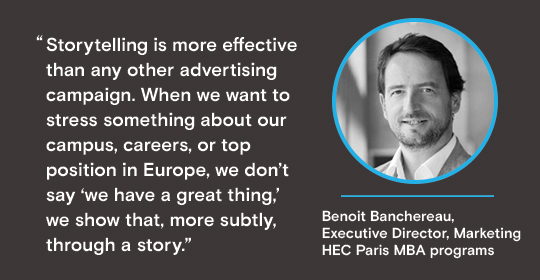In a crowded market for graduate management education, good content marketing helps connect business schools with prospective students. But how do you create an effective content marketing strategy?

Business school candidates today are faced with an abundance of program options to choose from, in various formats all over the world.
In this climate, business schools need to promote themselves more than ever before; to build brand recognition and communicate their distinctive program offering to prospective students in a meaningful and engaging way.
"Content marketing generates more than three times as many leads as outbound marketing (advertisements) and gets three times the leads-per-dollar spent compared to paid search."
- Content Marketing Institute
But how do you do good content marketing? Whether you’re creating written content, video, audio, infographics, social posts, or all the above, you need to carefully plan out your content marketing strategy before you begin.
Try following these five steps to create a winning content marketing strategy:
- Establish your goals
Before you launch a content marketing campaign, think about why you’re doing it. Is it about building brand awareness or generating applications for your school? Do you want to reach a particular audience? What are the key themes you want the audience to remember?
How you answer these questions should dictate the type of content you create and what your Call to Action (CTA) is for each content piece. I.e. What you want your audience to do next? (Associate your brand with a particular feature, recall your school when they start shortlisting, enquire for more information about your school, register for a webinar, or download a brochure, for example).
You should adopt this approach for each piece of content within a campaign. Think about how that piece of content will serve and create value for your audience. Will it be an article that entertains and inspires your audience (for example, an alumni success story)? Will it solve a problem (a video on how to choose between an MBA and an EMBA)? Will it help them in their time of need (a quick guide to visa applications)?
The value that the audience should receive from your content is what distinguishes content marketing from traditional advertising.

- Understand Your Audience
Because your audience are your potential customers, knowing who your audience is, what they’re interested in, and what stage of the application process they are at, is a crucial step in building a successful content marketing strategy.
To resonate the most, the content you create should vary depending on the type of audience you want to target. As well as digging into your website analytics, you should consider building audience profiles.
The Graduate Management Admission Council (GMAC), for example, categorizes the prospective student market into seven groups, from Respect Seekers (people who care a lot about a school’s ranking and reputation) to Global Strivers (people who want international careers) and Impactful Innovators (socially-minded entrepreneurs).
- Plan your distribution
Creating your content is just half the battle. What you do with the content after it’s created is just as important—and that needs to be in your mind from the point of creation.
Think about where your content will sit after it’s created to get it in front of your target audience; whether that’s deciding on a social media channel, newsletter format, or page on your website. LinkedIn, for example, is the most popular social media channel among MBA candidates, according to the Association of International Graduate Admissions Consultants (AIGAC), followed by YouTube and Facebook. Whilst email remains the preferred communication channel according to a prospective students survey carried out by GMAC in 2019.
Then, have a plan to stay engaged with your content once you launch your campaign. What can you tweak to make it perform better? Which social posts could benefit from some paid promotion? Keep your audience engaged by responding to their comments, suggesting additional content, and guiding them on what to do next.
- Think SEO
If you want to attract traffic to the content on your website over time, you’ll need to do some search engine optimization (SEO). This means ensuring your content is worded and structured in a way that helps it appear in internet (Google) search results.
Before you decide what content to include in your campaign, do some keyword research to find out what people actually search for, when they’re searching for Online MBAs for example. You’ll need to assess the competition: Are there other sites already performing well for that search term? Then, make sure your content includes the target keywords in the right places (title, meta description, and the body of the text).
Factors like site speed, mobile optimization, and the quantity and quality of links back to your site are also important when it comes to SEO.
SEO is not an exact science. But while you would need to keep putting money into something like Google Ads to get results, performing well in organic search results can help your content go further, for free.
- Review it
Three things distinguish content marketing from other types of advertising: the genuine value it offers a target audience; its relevance to that audience; and its consistency. Every content campaign should be built around consistently promoted themes that tie it together.
When you’ve created a content marketing campaign plan, take a step back and review it. Ask yourself whether you’ve matched those criteria. Ask yourself: Does this plan deliver on our goals? Will it make us stand out in a crowded market? Does it deliver against an audience's need?
Business schools all ultimately perform the same function: educating the business leaders of the future. For any content marketing campaign, you should look for a distinctive theme to focus on and stick to it. If your school wants to be known for its strength in finance, for example, create and share content on that theme so people will start associating your brand with it.
Want to learn more about how to create a winning content marketing strategy?
FREE Webinar | MARCH 24 | 5 Steps to Creating a Winning Content Marketing Strategy
